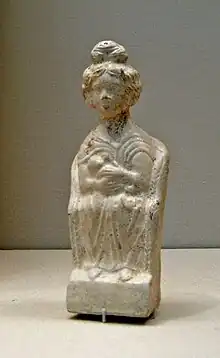Mater Matuta
Mater Matuta was an indigenous Latin goddess, whom the Romans eventually made equivalent to the dawn goddess Aurora, and the Greek goddess Eos.[1] She was the goddess of female maturation and later also of the dawn.[2] Her cult is attested several places in Latium; her most famous temple was located at Satricum. In Rome, she had a temple on the north side of the Forum Boarium, allegedly built by Servius Tullius, destroyed in 506 B.C., and rebuilt by Marcus Furius Camillus in 396 B.C.,[3] and she was also associated with the sea harbors and ports, where there were other temples to her.

Another remarkable place of worship was located in Campania, outside modern Capua. Dozens of votive statues representing matres matutae were found in the so-called "fondo Patturelli" (a private estate) during excavations in the 19th century.[4] An extensive collection of these votives is housed in the Museo Campano in Capua.[5]
Matralia
At Rome her festival was the Matralia, celebrated on June 11 at her temple in the Forum Boarium.[6] The festival was only for single women or women in their first marriage, who offered prayers for their nephews and nieces, and then drove a slave out of the temple.[7]
References
- Marcus Tullius Cicero, De Natura Deorum, II, 48.
- Forsythe, Gary (2005). A critical history of early Rome. Berkeley: University of California Press. p. 90. ISBN 978-0-520-94029-1. OCLC 70728478.
- Titus Livius, Ab Urbe Condita Libri, V, 19.
- George Kazantzidis and Dimos Spatharas (2018). Ancient Emotions I. Hope in Ancient Literature, History, and Art. Walter de Gruyter. ISBN 9783110598254. p. 311.
- The Mothers (Rooms V-VI-VII-VIII-IX) Archived 2018-11-07 at the Wayback Machine, Museo Campano Capua. Retrieved March 13, 2020.
- Chisholm, Hugh, ed. (1911). . Encyclopædia Britannica. Vol. 17 (11th ed.). Cambridge University Press. p. 878.
- Plutarch, Quaestiones Romanae, 16.
Further reading
- Desport, Marie. "Matuta, l'Aurore chez Évandre". In: Revue des Études Anciennes. Tome 49, 1947, n°1-2. pp. 111-129. [DOI: https://doi.org/10.3406/rea.1947.3366] ; [www.persee.fr/doc/rea_0035-2004_1947_num_49_1_3366]
- Flacelière, R. Deux rites du culte de « Mater Matuta », Plutarque, Camille, 5, 2.. In: Revue des Études Anciennes. Tome 52, 1950, n°1-2. pp. 18-27. DOI: https://doi.org/10.3406/rea.1950.3415; www.persee.fr/doc/rea_0035-2004_1950_num_52_1_3415
- Kaizer, Ted. Leucothea as Mater Matuta at Colonia Berytus. A note on local mythology in the Levant and the Hellenisation of a Phoenician city. In: Syria. Tome 82, 2005. pp. 199-206. DOI: https://doi.org/10.3406/syria.2005.8691 ; www.persee.fr/doc/syria_0039-7946_2005_num_82_1_8691
External links
- Chisholm, Hugh, ed. (1911). . Encyclopædia Britannica (11th ed.). Cambridge University Press.
 Media related to Mater Matuta at Wikimedia Commons
Media related to Mater Matuta at Wikimedia Commons